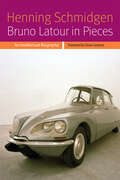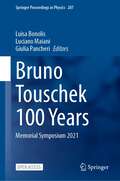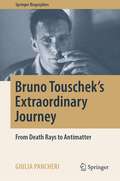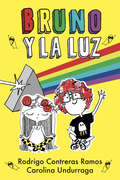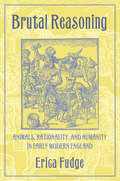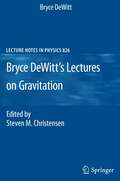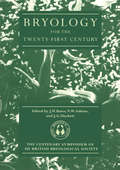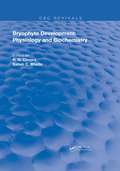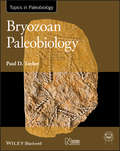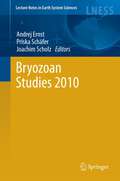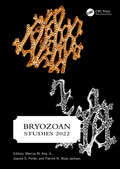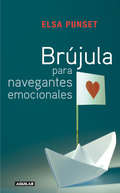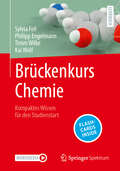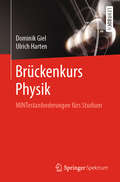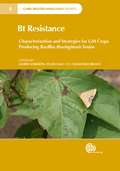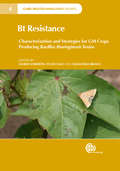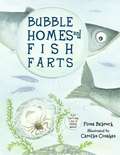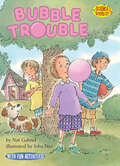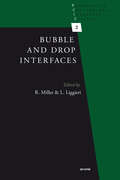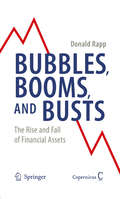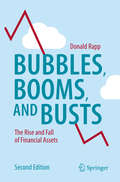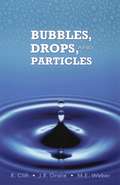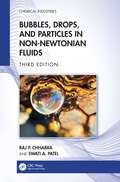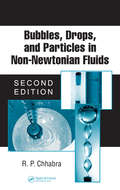- Table View
- List View
Bruno Latour in Pieces: An Intellectual Biography (Forms of Living)
by Henning SchmidgenBruno Latour stirs things up. Latour began as a lover of science and technology, co-founder of actor-network theory, and philosopher of a modernity that had “never been modern.” In the meantime he is regarded not just as one of the most intelligent—and also popular—exponents of science studies but also as a major innovator of the social sciences, an exemplary wanderer who walks the line between the sciences and the humanities.This book provides the first comprehensive overview of the Latourian oeuvre, from his early anthropological studies in Abidjan (Ivory Coast), to influential books like Laboratory Life and Science in Action, and his most recent reflections on an empirical metaphysics of “modes of existence.” In the course of this enquiry it becomes clear that the basic problem to which Latour’s work responds is that of social tradition, the transmission of experience and knowledge. What this empirical philosopher constantly grapples with is the complex relationship of knowledge, time, and culture.
Bruno Touschek 100 Years: Memorial Symposium 2021 (Springer Proceedings in Physics #287)
by Luciano Maiani Luisa Bonolis Giulia PancheriThis open access book celebrates the contribution of Bruno Touschek to theoretical physics and particle colliders in Europe. It contains direct testimonials from his former students, collaborators, and eminent scientists, among them, two Nobel Prize winners in Physics, Giorgio Parisi and Carlo Rubbia. It reviews the main developments in theoretical and accelerator physics in the second half of the twentieth century, while at the same time providing an overview of future prospects worldwide. This book is unique in that it will be of interest to historians of physics and also to the younger generation of researchers. Through the contribution of the leading protagonists, the interested scholar will learn about the past, present status, and relevance of both theoretical and experimental accelerator physics. The overview of Bruno Touschek’s life and works across Europe, from pre-war Vienna to Germany, the UK, Italy, and France, adds a human dimension to the scientific narration, while the open access status makes this laudatory book available to anyone with interest.
Bruno Touschek's Extraordinary Journey: From Death Rays to Antimatter (Springer Biographies)
by Giulia PancheriThis book tells the story of a unique scientific and human adventure, following the life and science of Bruno Touschek, an Austrian born physicist, who conceived and built AdA, the first matter-antimatter colliding-beam storage ring, the ancestor of the Large Hadron Collider at CERN where the Higgs Boson was discovered in 2012. Making extensive use of archival sources and personal correspondence, the author offers for the first time a unified history of European efforts to build modern-day particle accelerators, from the dark times of war-ravaged Europe up to the rebuilding of science in Germany, UK, Italy and France through the 1950s and early 1960s. This book, the result of several years of scholarly research work, includes numerous previously unpublished photos as well as original drawings by Bruno Touschek.
Bruno y la luz
by Rodrigo Contreras Carolina UndurragaEl segundo título de la serie de ficción que acerca la ciencia a l@s niñ@s En esta segunda entrega, Bruno recibe de regalo un telescopio, que resulta ser ¡una verdadera máquina para viajar en el tiempo! Así, y con la ayuda de su sabio amigo Hidrógenes, descubrirá el mensaje que trae la luz de las estrellas: un secreto que ha viajado por miles de millones de años y que guarda la historia del universo. Además, resolverá preguntas que se ha hecho siempre: ¿por qué el cielo es azul?, ¿por qué titilan las estrellas?, ¿por qué un zancudo puede picar a un humano a pesar de estar en una pieza completamente oscura? La serie continúa en: Bruno y las estrellas. Este libro explicará qué son las estrellas, cómo nacen, cuánto tiempo viven y cómo, a partir de su existencia, se crean todos los otros átomos que no aparecieron en el Big Bang y que dieron vida a nuevas estrellas y planetas. Bruno y la vida en el espacio. En esta aventura, Bruno viaja a la estación espacial internacional, donde viven los astronautas, a 400 kilómetros de la Tierra. ¡Imagina cómo es observar la vida en gravedad cero!
Brutal Reasoning: Animals, Rationality, and Humanity in Early Modern England
by Erica FudgeEarly modern English thinkers were fascinated by the subject of animal rationality, even before the appearance of Descartes's Discourse on the Method (1637) and its famous declaration of the automatism of animals. But as Erica Fudge relates in Brutal Reasoning, the discussions were not as straightforward—or as reflexively anthropocentric—as has been assumed. Surveying a wide range of texts-religious, philosophical, literary, even comic-Fudge explains the crucial role that reason played in conceptualizations of the human and the animal, as well as the distinctions between the two. Brutal Reasoning looks at the ways in which humans were conceptualized, at what being "human" meant, and at how humans could lose their humanity. It also takes up the questions of what made an animal an animal, why animals were studied in the early modern period, and at how people understood, and misunderstood, what they saw when they did look.From the influence of classical thinking on the human-animal divide and debates surrounding the rationality of women, children, and Native Americans to the frequent references in popular and pedagogical texts to Morocco the Intelligent Horse, Fudge gives a new and vital context to the human perception of animals in this period. At the same time, she challenges overly simplistic notions about early modern attitudes to animals and about the impact of those attitudes on modern culture.
Bryce DeWitt's Lectures on Gravitation: Edited by Steven M. Christensen (Lecture Notes in Physics #826)
by Steven M. Christensen Bryce DewittBryce DeWitt, a student of Nobel Laureate Julian Schwinger, was himself one of the towering figures in 20th century physics, particularly renowned for his seminal contributions to quantum field theory, numerical relativity and quantum gravity. In late 1971 DeWitt gave a course on gravitation at Stanford University, leaving almost 400 pages of detailed handwritten notes. Written with clarity and authority, and edited by his former student Steven Christensen, these timeless lecture notes, containing material or expositions not found in any other textbooks, are a gem to be discovered or re-discovered by anyone seriously interested in the study of gravitational physics.
Bryology for the Twenty-first Century (Maney Main Publications)
by Jeffrey W. BatesA compilation of state of the art papers on key topics in bryology from invited speakers at the Centenary Symposium, University of Glasgow, 57 August 1996.
Bryophyte Development: Physiology and Biochemistry (Routledge Revivals)
by R. N. Chopra Satish C. BhatlaPublished in 1990: With the accumulation of knowledge in the newer areas of investigations and the increasing degree of specialization, the most satisfactory way of bringing together authentic information in one volume is to invite the specialists in each area to contribute.
Bryozoan Paleobiology (TOPA Topics in Paleobiology)
by Paul D. TaylorBryozoa are among the most abundant yet least understood of phyla in the fossil record. These exclusively colonial animals can be traced back to the Ordovician as fossils and are common elements of sediments deposited in shallow marine environments. On occasion their calcareous skeletons are sufficiently numerous to produce bryozoan limestones. The potential of bryozoans in facies analysis, and their use in macroevolutionary studies, have both been widely recognised, but to date have been incompletely exploited. Bryozoan Paleobiology brings together the scattered research on living and fossil bryozoans in broad and profusely illustrated overview that will help students and researchers alike in understanding this fascinating group of animals. Beginning with the basics of bryozoan morphology, ecology and classification, the book progresses from the smallest scale of skeletal ultrastructure, to the largest of bryozoan distributions in time and space. On the way, topics such as the origin of zooidal polymorphism and macroevolutionary trends in colony forms are covered. Case studies illuminate these topics, and areas in which further research is particularly required are highlighted.
Bryozoan Studies 2010 (Lecture Notes in Earth System Sciences #143)
by Andrej Ernst Joachim Scholz Priska SchäferBryozoa are a colonial animal phylum with a long evolutionary history, having existed from the early Ordovician (480 My) onward and still flourishing today. Several mass extinctions in earth history shaped and triggered bryozoan evolution through drastic turnover of faunas and new evolutionary lineages. Bryozoa are widespread across all latitudes from Equator to Polar Regions and occur in marine and freshwater environments. They are shaping benthic ecosystems and recording ambient environmental conditions in their skeletons. The book provides a synthesis of the current main topics of research in the field of Bryozoology including combined research on both extant, and extinct taxa. Fields or current research span molecular genetics and phylogeny, life history, reproduction and anatomy, biodiversity and evolutionary patterns in time and space, taxonomy, zoogeography, ecology, sediment interactions, and climate response.
Bryozoan Studies 2022: PROCEEDINGS OF THE NINETEENTH INTERNATIONAL BRYOZOOLOGY ASSOCIATION CONFERENCE (DUBLIN, IRELAND, 22-26 AUGUST 2022)
by Marcus M. Key Joanne S. Porter Wyse Jackson, Patrick N.Bryozoan Studies 2022 contains nineteen papers presented at the 19th International Conference of the International Bryozoology Association held at Trinity College Dublin in August 2022. Bryozoans are complex and fascinating colonial organisms that range from Cambrian to the present day and which are found in marine and freshwater environments from pole to pole and subtidal to abyssal. Recent tomographic techniques have revolutionised the study of modern and fossil taxa where internal structures are revealed through non-destructive methodologies. Here the internal structure of some Ordovician and Eocene taxa is illustrated through these methods. Phylogenetic studies of bryozoans question the classic classification of the group; here the phylogeny of species from California and Japan is described. Other topics covered are assessments of Recent faunas from Haiti and fossil assemblages from Mexico and the United States. Distributional patterns from the Arctic and New Zealand and the dispersal patterns of bryozoans on rafted pumice and on slipper lobsters are characterised. Further contributions provide descriptions of a rare Permian taxon, clarification of species assigned to the Upper Palaeozoic genus Stenopora, avicularia in Wilbertopora, enigmatic structures in a fenestrate bryozoan, repair structures in trepostomes, and an assessment of skeletonisation in the families of Palaeozoic orders.
Brújula para navegantes emocionales
by Elsa PunsetConocerse a uno mismo permite descubrir las fuentes de nuestra felicidad, nuestra ira y nuestro dolor para poder convivir armoniosa y plenamente con nosotros mismos y con los demás. En el fondo instintivo de nuestro ser, no pensamos, sentimos. Estamos hechos de emociones. A lo largo de los siglos nos habíamos esforzado en encerrarlas en sistemas de vida ordenados y represivos. Ante su dictado solo cabía resignarse o rebelarse. Actualmente vivimos en un mundo que nos abruma con tentaciones y decisiones múltiples y tenemos que decidir en soledad quiénes somos y por qué nos merece la pena vivir. Esta nueva libertad reclama la adquisición de una brújula que nos permita navegar con inteligencia emocional por los cauces imprevisibles de nuestras vidas. Este libro recorre las distintas etapas de maduración emocional y social del ser humano no solo como individuo, sino también en relación a las personas que conforman nuestro entorno: padres, hijos, pareja, compañeros, amigos... En el siglo XXI las emociones, gracias a las puertas que ha abierto la neurociencia, pueden catalogarse, comprenderse e incluso gestionarse: son la llave de nuestro centro neurálgico, llámese cerebro, alma, conciencia o libre alberdrío. La crítica ha dicho...«Uno de los mejores libros de divulgación científica del año.»El Mundo
Brückenkurs Chemie: Kompaktes Wissen für den Studienstart
by Sylvia Feil Philipp Engelmann Timm Wilke Kai WolfChemie ist eine wichtige Basis für alle naturwissenschaftlichen Fächer und dieses Lehrbuch hilft dir, den Durch- und Überblick zu behalten. Denn in den ersten Semestern gilt es, sehr viel Lernstoff zu bewältigen. Themenbereiche aus der Schule zur anorganischen, organischen und physikalischen Chemie werden aufgefrischt und zum Einstieg ins Studienwissen erweitert. Wie in einem Vorkurs geht es um: Struktur und Nomenklatur chemischer Verbindungen, den Aufbau des Periodensystems, Reaktionsarten sowie -abläufe, die Stöchiometrie zum Aufstellen von Reaktionsgleichungen oder auch energetische und kinetische Aspekte von chemischen Reaktionen. Statt dir eine Faktensammlung zu präsentieren, kannst du die Themen vom Einfachen zum Komplexen verstehen. Auch auf das laborpraktische Arbeiten, einen sinnvollen Umgang mit KI im Studium sowie das Unileben als Ganzes bereiten wir dich vor. Mit dem Brückenkurs Chemie und seinen digitalen Übungen auf der Springer Nature Flashcards-App bahnst du dir leichter den Weg von der Schule ins Studium.
Brückenkurs Physik: MINTestanforderungen fürs Studium
by Ulrich Harten Dominik GielDieses Lehrbuch fasst alle wesentlichen, für das Studium eines MINT-Faches relevanten Inhalte der Physik zusammen und hilft physikalisches Grundwissen aufzufrischen. Es unterstützt Studienanfänger dabei, die Routine in der konkreten Anwendung, die an der Hochschule vorausgesetzt wird, zu festigen. Dabei folgt die Stoffauswahl dem Mindestanforderungskatalog Physik, den ein Arbeitskreis aus Professoren der baden-württembergischen Hochschulen für angewandte Wissenschaften zusammengestellt hat. Die Grundbegriffe aus Mechanik, Elektrizität, Wärmelehre und Optik werden verständlich dargestellt und durch zahlreiche Abbildungen veranschaulicht. Durch mehr als 111 Übungsaufgaben mit Lösungen kann der Leser seine Fähigkeiten selbständig überprüfen, erweitern und trainieren. So bietet dieses Werk als Brückenkurs eine optimale Vorbereitung für die Vorlesungen zur Physik – und leistet auch darüber hinaus in ersten zwei Semestern zur Vorbereitung von Übungszetteln und den ersten Klausuren wertvolle Dienste.
Bt Resistance
by Alejandra Bravo Mario Soberón Yulin GaoBacillus thuringiensis (Bt) bacteria use Cry proteins to kill their insect larval hosts. The expression of certain Cry toxins in transgenic crops has been widely used to achieve efficient control of insect pests. This book describes the use of Bt crops and the emerging problem of resistance, recent progress in understanding the mechanism of action of Bt toxins, different resistance mechanisms and strategies to cope with resistance in the field. It describes resistant insects found in the field in different countries, particularly in the developing world, and ways to counter resistance such as gene stalking, refuges, modified toxins and gene discovery of novel toxins with different mode of action.
Bt Resistance: Characterization and Strategies for GM Crops Producing Bacillus thuringiensis Toxins (CABI Biotechnology Series)
by Alejandra Bravo Mario Soberón Yulin GaoThis book describes the use of Bt crops and the emerging problem of resistance. Covering recent progress in understanding the mechanism of action of Bt toxins, different resistance mechanisms and strategies to cope with resistance in the field, it reviews successes and failures from around the world.
Bubble Homes and Fish Farts
by Fiona BayrockA book that takes a look at the many ways different animals, from dolphins to spittlebugs to water shrews, use bubbles.
Bubble Trouble (Science Solves It!)
by Nat GabrielSolve kid-sized dilemmas and mysteries with the Science Solves It! series. These fun science books for kids ages 5–8 blend clever stories with real-life science. Why did the dog turn green? Can you control a hiccup? Is that a UFO? Find the answers to these questions and more as kid characters dive into physical, life, and earth sciences. Grace wants to join her big sister Jane's Bubble Gum Club, but she can't blow a bubble. So Grace finds a good science book and performs a few experiments involving air and bubble-making. When Jane blows up more than she can chew, can Grace save the day -- and find a way into the club? Books in this perfect STEM series will help kids think like scientists and get ahead in the classroom. Activities and experiments are included in every book! (Level One; Science topic: Bubbles)
Bubble and Drop Interfaces (Progress in Colloid and Interface Science)
by R. Miller L. LiggieriThis book describes the most important experimental methods for characterizing liquid interfaces, such as drop profile analysis, bubble pressure and drop volume tensiometry, capillary pressure technique, and oscillating drops and bubbles. It presents practical experimental details as well as the underlying theoretical bases. In addition, the book c
Bubble and Foam Chemistry
by Robert J. PughThis indispensable guide will equip the reader with a thorough understanding of the field of foaming chemistry. Assuming only basic theoretical background knowledge, the book provides a straightforward introduction to the principles and properties of foams and foaming surfactants. It discusses the key ideas that underpin why foaming occurs, how it can be avoided and how different degrees of antifoaming can be achieved, and covers the latest test methods, including laboratory and industrial developed techniques. Detailing a variety of different kinds of foams, from wet detergents and food foams, to polymeric, material and metal foams, it connects theory to real-world applications and recent developments in foam research. Combining academic and industrial viewpoints, this book is the definitive stand-alone resource for researchers, students and industrialists working on foam technology, colloidal systems in the field of chemical engineering, fluid mechanics, physical chemistry, and applied physics.
Bubbles, Booms, and Busts: The Rise and Fall of Financial Assets
by Donald RappThis book provides a thorough explanation of the nature and history of booms, bubbles and busts in financial markets. The first part of the book deals with financial booms and bubbles and how they emerge, develop and collapse. It describes the distribution of wealth, inflation, rationality of bankers, monetary and fiscal policy, the role of central banks, tax policies, social security, US federal, state, municipal and personal debt, and valuation of common stocks. The book describes historical boom/bust cycles including bubbles of the 1720s, the Florida land boom and the stock market in the 1920s, the depression of the 1930s, the S&L scandal of the 1980s, the great bull market of 1982-1995, the crash of 1987, the dot.com mania of 1995-2000, corporate swindles of the 1990s and 2000s, the sub-prime fiasco of the 2000s, and Japan in the late 20th century. Most of the recent wealth generation has derived from increased debt and appreciation of paper assets. The architects of the new economics were Ronald Reagan and Arthur Greenspan. Inevitably, the US Government's cure for excessive spending and inadequate revenues is to increase spending and cut revenues. American voters must choose between "tax and spend" Democrats and "spend and borrow" Republicans. The theme of American finance was uttered by VP Cheney: "Deficits don't matter".
Bubbles, Booms, and Busts: The Rise and Fall of Financial Assets
by Donald RappThis book deals at some length with the question: Since there are many more poor than rich, why don’t the poor just tax the rich heavily and reduce the inequality? In the 19th century and the first half of the 20th century, the topic of inequality was discussed widely. Ending or reducing inequality was a prime motivating factor in the emergence of communism and socialism. The book discusses why later in the 20th century, inequality has faded out as an issue. Extensive tables and graphs of data are presented showing the extent of inequality in America, as well as globally. It is shown that a combination of low taxes on capital gains contributed to a series of real estate and stock bubbles that provided great wealth to the top tiers, while real income for average workers stagnated. Improved commercial efficiency due to computers, electronics, the Internet and fast transport allowed production and distribution with fewer workers, just as the advent of electrification, mechanization, production lines, vehicles and trains in the 1920s and 1930s produced the same stagnating effect.
Bubbles, Drops, and Particles
by J. R. Grace R. Clift M. E. WeberThis volume offers a critical review of the literature concerning the fluid dynamics, heat transfer, and mass transfer of single bubbles, drops, and particles. Upper-level undergraduates and graduate students, as well as professionals in the fields of engineering, physics, chemistry, geophysics, and applied mathematics, will find it a unified treatment of solid particles, liquid drops, and gas bubbles.Starting with a summary of the fundamental principles and equations governing the behavior of bubbles, drops, and solid particles in Newtonian fluids, the text proceeds to a survey of the parameters used to characterize the shape of rigid particles, and of the factors that determine the shape of bubbles and drops. Succeeding chapters examine the behavior of solid and fluid particles under steady incompressible flow in an extended external phase. The text concludes with an exploration of effects that complicate the relatively simple case of a particle moving steadily through an unbounded fluid.
Bubbles, Drops, and Particles in Non-Newtonian Fluids (Chemical Industries)
by Raj P. Chhabra Swati A. PatelThe third edition of Bubbles, Drops, and Particles in Non-Newtonian Fluids provides comprehensive coverage of the scientific foundations and the latest advances in particle motion in non-Newtonian media. Thoroughly updating and expanding its best-selling predecessor, this edition addresses numerical and experimental developments in non-Newtonian particulate systems. It includes a new chapter on heat transfer in non-Newtonian fluids in the free and mixed convection regimes and thus covers forced convection regimes separately in this edition. Salient Features: Demonstrates how dynamic behavior of single particles can yield useful information for modeling transport processes in complex multiphase flows. Addresses heat transfer in Generalized Newtonian Fluid (GNF), visco-plastic and visco-elastic fluids throughout the book and outlines potential strategies for heat transfer enhancement. Provides a new detailed section on the effect of confinement on heat transfer from bluff-bodies in non-Newtonian fluids. Written in a clear and concise manner, this book remains an excellent handbook and reference. It is essential reading for students and researchers interested in exploring particle motion in different types of non-Newtonian systems encountered in disciplines across engineering and the sciences.
Bubbles, Drops, and Particles in Non-Newtonian Fluids (ISSN)
by R.P. ChhabraBubbles, Drops, and Particles in Non-Newtonian Fluids, Second Edition continues to provide thorough coverage of the scientific foundations and the latest advances in particle motion in non-Newtonian media. The book demonstrates how dynamic behavior of single particles can yield useful information for modeling transport processes in complex multipha
